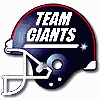|
|
| E-GIANTS
By Dave Klein There is more passing these days, far more, say, then even 10 years ago, and that means the quarterback is going to be back there reasonably exposed to the big, fast rushers. An off-shoot of this is the gradual evolution of bigger, faster ends, and the Giants' Jason Pierre-Paul comes quickly to mind. This brings to mind the words of an old defensive line coach, when asked how he schooled his ends and tackles to beat the o-linemen and get to the quarterback. "I just tell them that the quarterback is the guy who stole their pizza and their box of Oreos," he laughed, "and you should see what happened next." This new style of offense also places a premium on tackles and guards who are more proficient in pass-blocking, and except in a few instances the left tackle - the guy who protects the quarterback's blind side - has become a rare commodity. Those exceptions? A team that features a left-handed quarterback, of course, which puts the pressure of protecting his blind side on the right tackle. "You'll find you need a pass rush from the ends about 30 to 40 times a game," says one scout, "and that never was the case years ago. They are looking for them in the colleges now, the guys with great strength and quickness, probably a lot of them who played basketball." Does that mean someone such as Pierre-Paul of the Giants is going to be - or is - the new icon for pass rushers? Yes, but he is going to be one of several in the next few years. The game of football, as virtually everything else, is cyclical. The Giants have JPP and Justin Tuck; they plan to use Pro Bowl veteran Osi Umenyiora if he stops complaining long enough to play; they will use linebacker (formerly defensive end) Mathias Kiwanuka as a pass-rusher in Perry Fewell's complicated but effective formations. Until last month they called extensively on reserve end Dave Tollefson. Even tall, quick linebackers come into play - and there never was a pass-rushing from any position better than Lawrence Taylor, who was well ahead of his time. In the recently-concluded draft, the lure and attraction of these hybrid defensive ends/linebackers was evident. New England (Chandler Jones), the Jets (Quinton Coples), Houston (Whitney Mercilus) and Green Bay (Nick Perry) all opted for first-round picks at that position. The Ravens struck early in the second round by taking Courtney Upshaw. Will any of them become this year's JPP? That will take time to determine, but any player who reaches stardom as quickly as he did will be another rarity. There is no question that the game has changed. Years and years ago, Hall of Fame middle linebacker Sam Huff played for the Giants at six feet and 210 pounds. He couldn't even be a big safety these days. Another Hall of Famer, offensive tackle Rosey Brown, was 6-3 and 255 and he was one of the two best tackles in the league. The other? Baltimore's Jim Parker, who was 6-3 and 265. There was no such thing as a 300-pounder except for the few who were termed freaks, generally kept around for purposes of intimidation. Yet even Parker and Brown weren't quick, not like today's players. "What has happened," said former Giants' strength and conditioning coach Johnny Parker, "is that the players kept developing and evolving and they made the field smaller. You can't run away from anybody these days, not even the big guys." John Madden, and even young people know him for his Madden Football stuff, was standing in the bowels of old Giants Stadium the day the Giants clinched their first-ever Super Bowl appearance, and they knew by then that their opponent would be Denver. "Can the Giants beat the Broncos?" a guy asked Madden. He snorted in response. "Hey, what's [John] Elway going to do?" he responded. "He can't scramble. The Giants' outside linebackers [Lawrence Taylor and Carl Banks] are bigger than he is by 35 pounds and they're faster, too. It's a no-contest kind of game." But back to the defensive ends, today's pass-rushers. They are at a premium, as are pass-blocking O-linemen, and you can trade the gradual trend toward not only bigger but quicker linemen easily. This is why a complainer like Umenyiora still demands mega-millions, and why guys like Mario Williams and Julius Peppers and the recently retired Michael Strahan and Robert Mathis and Jared Allen are so highly-paid. The teams that draft for the new commodity will be successful; the ones that don't will see their quarterbacks pancaked. EXTRA POINTS -- First of all, the answers to Thursday's trivia question: In 1983, Penn State's Todd Blackledge was the second of the NFL record six quarterbacks drafted in the first round; Pitt's Dan Marino was the sixth. ... And that year the Giants' first round selection was safety Terry Kinard of Clemson. Check out Dave's website at E-GIANTS
where you can subscribe to his newsletters which
run much more frequently than what is available here. NEW - Send a request to davesklein@aol.com for a free week's worth of news!
| ||||||||
|
Stop
in and visit "Mike's
Keys to the Internet" |
| |
